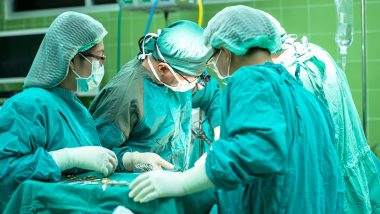Mumbai: Teenage Schoolgirl Anamta Aqeel Ahmad Becomes World’s Youngest To Get Limb Transplant
By Lokmat English Desk | Updated: September 27, 2024 16:24 IST2024-09-27T16:19:58+5:302024-09-27T16:24:39+5:30
Anamta Ahmad, a 15-year-old girl from Mumbai, who lost her right hand to electrocution in 2022, has made history ...

Mumbai: Teenage Schoolgirl Anamta Aqeel Ahmad Becomes World’s Youngest To Get Limb Transplant
Anamta Ahmad, a 15-year-old girl from Mumbai, who lost her right hand to electrocution in 2022, has made history as the youngest person in Asia and the first worldwide to undergo a successful shoulder-level limb transplant, as confirmed by Gleneagles Hospital in Parel, Mumbai. This operation marks the hospital's 12th successful hand transplant and is a significant milestone for India, as it is the first time a hand transplant was performed using the limb of a nine-year-old brain-dead donor from Surat, Gujarat. The 12-hour procedure was led by Dr. Nilesh G. Satbhai, the Head of Plastic, Hand, Reconstructive Microsurgery, and Transplantation at Gleneagles Hospitals, along with his team.
After having her right arm amputated just below the shoulder level, the recipient is now on track to recover and regain normal movements and function of her new arm. The young girl is thrilled about her new opportunity and eagerly anticipates returning to school. Two years ago, 13-year-old Anamta from Mumbai travelled to her hometown of Aligarh in Uttar Pradesh for a vacation. While playing with her cousins, she accidentally touched an 11KV wire on the terrace, resulting in a severe electric shock that caused significant burns. Her right hand developed gangrene and had to be amputated thrice. Her left arm was also severely injured with poor function.Since that tragic incident, Anamta and her family did not lose hope.
Eventually, Anamta found the strength within herself to confront the difficult truth and come to terms with the necessity of restarting her life and relearning various skills. She refused to take assistance from her family members chose to be self-reliant and tackled all her daily responsibilities independently. She maintained an optimistic outlook, returned to school without pausing her education, learned to write with her left hand, and scored 92 percent marks (the highest in five subjects) in her Class 10 examinations. She excelled in Hindi at her school with an impressive score of 98 in May 2024.Meanwhile, the family kept searching for options and solutions for this difficult situation they were facing. They soon realized that hand transplantation was the only suitable solution and visited multiple hospitals across India, and also a few centers in Singapore and Thailand, but could not make progress. Finally they came to Gleneagles Hospital, Mumbai and consulted Dr Satbhai.
Anamta underwent a detailed preoperative workup and was listed for hand transplantation. After waiting for more than a year, they got an alert about the availability of a suitable hand donor.Dr Nilesh G. Satbhai, said, “We were informed by the local state authorities, that a nine-year-old girl from Surat, who was suffering from a brain tumor, had been declared brain dead. The family was counselled by a local NGO about hand donation. The parents generously consented for the donation, and arrangements were promptly organized to transfer the organ to Gleneagles Hospitals.” Dr Satbhai added, “Hand transplantation is a complex procedure which requires detailed assessment of the recipient. The primary injury often results in severe scarring of the skin, blood vessels and nerves. We need to assess this beforehand and plan accordingly. In transplantation at higher levels, bony fixation is a challenge as well.
In Anamta’s case, as the injury was almost at shoulder level, we had to repair the blood vessels and nerves at a very high level under the clavicle (collar bone). This can be technically very challenging. The most important factor is to restore the circulation of the donor hands within six hours, so that it survives and functions well, without causing any risk to the recipient.”“Anamta’s surgery took almost 12 hours and required great teamwork of surgeons, anesthesiologists, immunologists and intensive care physicians. The patient is recovering well and is still in the ICU for observation. She will be on life-long immunosuppression. Her physiotherapy and rehabilitation will start soon. It usually takes 9-12 months for functional recovery after such proximal transplants,” Dr Satbhai stated.
Open in app